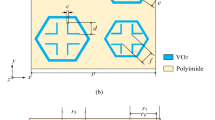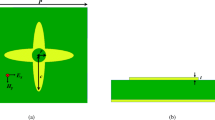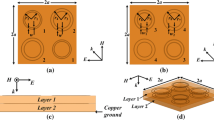Abstract
In this work, we present the design of a polarization independent broadband absorber in the terahertz (THz) frequency range using a metasurface resonator. The absorber comprises of three layers, of which, the top layer is made of a vanadium dioxide (VO2) resonator with an electrical conductivity of σ = 200000 S/m; the bottom layer consists of a planar layer made of gold metal, and a dielectric layer is sandwiched between these two layers. The optimized absorber exhibits absorption greater than 90% from 2.54–5.54 THz. Thus, the corresponding bandwidth of the designed absorber is 3 THz. Further, the thermal tunable absorption and reflection spectra have been analyzed by varying the electrical conductivity of VO2. The impact of the various geometrical parameters on the absorption characteristics has also been assessed. The physics of generation of broadband absorption of the proposed device has been explored using field analysis. Finally, the absorption characteristics of the unit cell has been studied for various incident and polarization angles.

Similar content being viewed by others
References
Sirtori C. Bridge for the terahertz gap. Nature, 2002, 417(6885): 132–133
Tonouchi M. Cutting-edge terahertz technology. Nature Photonics, 2007, 1(2): 97–105
Jepsen P U, Cooke D G, Koch M. Terahertz spectroscopy and imaging-modern techniques and applications. Laser & Photonics Reviews, 2011, 5(1): 124–166
Federici J F, Schulkin B, Huang F, Gary D, Barat R, Oliveira F, Zimdars D. THz imaging and sensing for security applications—explosives, weapons and drugs. Semiconductor Science and Technology, 2005, 20(7): S266–S280
Salisbury W W. Absorbent body for electromagnetic waves. United States Patent US 2599944. 1952
Knott E F, Schaeffer J F, Tulley M T. Radar Cross Section. Raleigh: SciTech Publishing, 2004
Watts C M, Liu X, Padilla W J. Metamaterial electromagnetic wave absorbers. Advanced Materials, 2012, 24(23): OP98–OP120, OP181
Landy N I, Sajuyigbe S, Mock J J, Smith D R, Padilla W J. Perfect metamaterial absorber. Physical Review Letters, 2008, 100(20): 207402
Li H, Yuan L H, Zhou B, Shen X P, Cheng Q, Cui T J. Ultrathin multiband gigahertz metamaterial absorbers. Journal of Applied Physics, 2011, 110(1): 014909
Sharma S K, Ghosh S, Srivastava K V. An ultra-thin triple-band polarization-insensitive metamaterial absorber for S, C and X band applications. Applied Physics A, Materials Science & Processing, 2016, 122(12): 1071
Wen Y, Ma W, Bailey J, Matmon G, Yu X. Broadband terahertz metamaterial absorber based on asymmetric resonators with perfect absorption. IEEE Transactions on Terahertz Science and Technology, 2015, 5(3): 406–411
Zhang B, Zhao Y, Hao Q, Kiraly B, Khoo I C, Chen S, Huang T J. Polarization-independent dual-band infrared perfect absorber based on a metal-dielectric-metal elliptical nanodisk array. Optics Express, 2011, 19(16): 15221–15228
Ghobadi A, Dereshgi S A, Hajian H, Bozok B, Butun B, Ozbay E. Ultra-broadband, wide angle absorber utilizing metal insulator multilayers stack with a multi-thickness metal surface texture. Scientific Reports, 2017, 7(1): 4755
Tao H, Landy N I, Bingham C M, Zhang X, Averitt R D, Padilla W J. A metamaterial absorber for the terahertz regime: design, fabrication and characterization. Optics Express, 2008, 16(10): 7181–7188
Wang B X, **e Q, Dong G, Huang W Q. Broadband terahertz perfect light absorber based on the modes of fundamental response and surface lattice resonance. OSA Continuum, 2018, 1(1): 213–220
Wen Q Y, Zhang H W, **e Y S, Yang Q H, Liu Y L. Dual band terahertz metamaterial absorber: design, fabrication, and characterization. Applied Physics Letters, 2009, 95(24): 241111
Chen C, Can S, Schalch J, Zhao X, Duan G, Averitt R D, Zhang X. Ultrathin terahertz triple-band metamaterial absorbers: consideration of interlayer coupling. Physical Review Applied, 2020, 14(5): 054021
Wang B X, Tang C, Niu Q, He Y, Chen T. Design of narrow discrete distances of dual-/triple-band terahertz metamaterial absorbers. Nanoscale Research Letters, 2019, 14(1): 64
Liu S, Zhuge J, Ma S, Chen H, Bao D, He Q, Zhou L, Cui T J. A bilayered quad-band metamaterial absorber at terahertz frequencies. Journal of Applied Physics, 2015, 118(24): 245304
Wang B X, Wang G Z. Quad-band terahertz absorber based on a simple design of metamaterial resonator. IEEE Photonics Journal, 2016, 8(6): 1–8
Arabmohammadi M, Kashani Z G, Sheikhan R A. Numerical analysis and circuit model of tunable dual-band terahertz absorbers composed of concentric graphene disks and rings. Journal of Electronic Materials, 2020, 49(10): 5721–5729
Su W, Chen X, Geng Z. Dynamically tunable dual-frequency terahertz absorber based on graphene rings. IEEE Photonics Journal, 2019, 11(6): 1–8
Nejat M, Nozhat N. Design, theory, and circuit model of wideband, tunable and polarization-insensitive terahertz absorber based on graphene. IEEE Transactions on Nanotechnology, 2019, 18: 684–690
Huang X, He W, Yang F, Ran J, Yang Q, **e S. Thermally tunable metamaterial absorber based on strontium titanate in the terahertz regime. Optical Materials Express, 2019, 9(3): 1377–1385
Wang Z L, Hu C X, Liu H B, Zhang H F. A newfangled terahertz absorber tuned temper by temperature field doped by the liquid metal. Plasmonics, 2021, 16(2): 425–434
Zhang H F, Wang Z L, Hu C X, Liu H B. A tailored broadband terahertz metamaterial absorber based on the thermal expansion feature of liquid metal. Results in Physics, 2020, 16: 102937
Luo H, Cheng Y. Thermally tunable terahertz metasurface absorber based on all dielectric indium antimonide resonator structure. Optical Materials, 2020, 102: 109801
Kong X R, Dao R N, Zhang H F. A tunable double-decker ultra-broadband THz absorber based on a phase change material. Plasmonics, 2019, 14(5): 1233–1241
Zhang Y, Wu P, Zhou Z, Chen X, Yi Z, Zhu J, Zhang T, Jile H. Study on temperature adjustable terahertz metamaterial absorber based on vanadium dioxide. IEEE Access: Practical Innovations, Open Solutions, 2020, 8: 85154–85161
Zhang C, Huang C, Pu M, Song J, Luo X. Tunable absorbers based on an electrically controlled resistive layer. Plasmonics, 2019, 14(2): 327–333
Yuan S, Yang R, Tian J, Zhang W. A photoexcited switchable tristate terahertz metamaterial absorber. International Journal of RF and Microwave Computer-Aided Engineering, 2020, 30(1): e22014
Wang B X, Wang G Z, Zhu H. Quad-band terahertz absorption enabled using a rectangle-shaped resonator cut with an air gap. RSC Advances, 2017, 7(43): 26888–26893
Cai H, Chen S, Zou C, Huang Q, Liu Y, Hu X, Fu Z, Zhao Y, He H, Lu Y. Multifunctional hybrid metasurfaces for dynamic tuning of terahertz waves. Advanced Optical Materials, 2018, 6(14): 1800257
Wang S, Kang L, Werner D H. Hybrid resonators and highly tunable terahertz metamaterials enabled by vanadium dioxide (VO2). Scientific Reports, 2017, 7(1): 4326
Zhou J, Zhang L, Tuttle G, Koschny T, Soukoulis C M. Negative index materials using simple short wire pairs. Physical Review B, 2006, 73(4): 041101
Ye Y Q, ** Y, He S. Omnidirectional, polarization-insensitive and broadband thin absorber in the terahertz regime. Journal of the Optical Society of America B, Optical Physics, 2010, 27(3): 498–504
Ding F, Cui Y, Ge X, ** Y, He S. Ultra-broadband microwave metamaterial absorber. Applied Physics Letters, 2012, 100(10): 103506
Smith D R, Vier D C, Koschny T, Soukoulis C M. Electromagnetic parameter retrieval from inhomogeneous metamaterials. Physical Review E, 2005, 71 (3 Pt 2B): 036617
Author information
Authors and Affiliations
Corresponding author
Additional information
C. Gandhi received his M.Sc. degree in Physics from Loyola College, India. He received his Ph.D. degree in Physics from Vellore Institute of Technology, India. His main research interests include terahertz absorber and polarization converter using metamaterials.
P. Ramesh Babu has worked in the Department of Physics at Vellore Institute of Technology, India, for the last thirty years, of which, he has been a professor since 2009. He received his Ph.D. degree from University of Madras, India, in 2006. His doctoral thesis focussed on the generation of Bragg solitons in a photonic bandgap structure. His research interests include nonlinear fiber optics, photonic crystal fibers, Bose-Einstein condensation, metamaterials and plasmonic sensors. He has published more than 50 papers in high-profile journals that include IEEE Journal of Selected Topics in Quantum Electronics, IEEE Sensors, Optical Fiber Technology, Current Science, Journal of Modern Optics, Optical Engineering, etc. He is a life member of Indian Association of Physics Teachers, Indian Laser Association and Indian Society for Technical Education.
K. Senthilnathan is a professor at Vellore Institute of Technology (VIT), India. He earned his M.Sc. and M.Phil. degrees in Physics from the University of Madras, India, and Ph.D. degree from Anna University, India. He carried out post-doctoral research at The Hong Kong Polytechnic University, China, from Dec. 2005 to Aug. 2008. Then, he served as Assistant Professor in NIT Rourkela from Sep. 2008 to Jun. 2010. Later, he joined VIT in Jul. 2010 as Assistant Professor. His areas of research include optical fibers, fiber Bragg gratings, photonic crystal fibers, pulse compression, Bose-Einstein condensation and metamaterials. Besides, he has also been focusing on develo** various types of fiber sensors including micro-structured fibers. These results have been disseminated in various prestigious international journals that include Journal of the Optical Society of America B, IEEE Journal of Quantum Electronics, IEEE Journal of Lightwave Technology, IEEE Photonics Technology Letters, IEEE Sensors, IEEE Journal of Selected Topics in Quantum Electronics, etc. He has more than 100 Scopus indexed publications.
Rights and permissions
About this article
Cite this article
Gandhi, C., Babu, P.R. & Senthilnathan, K. Ultra-thin polarization independent broadband terahertz metamaterial absorber. Front. Optoelectron. 14, 288–297 (2021). https://doi.org/10.1007/s12200-021-1223-3
Received:
Accepted:
Published:
Issue Date:
DOI: https://doi.org/10.1007/s12200-021-1223-3




